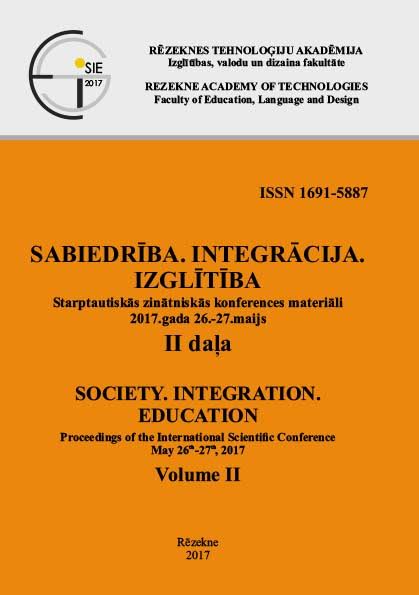PRECONDITIONS FOR THE SUCCESSFUL INTEGRATION OF DISABLED PERSONS INTO THE LABOUR MARKET
DOI:
https://doi.org/10.17770/sie2017vol2.2358Keywords:
disabled persons, integration, labour market, vocational rehabilitationAbstract
Low activity level of disabled persons is closely related to the lack of their vocational skills, qualification, experience and motivation. All of the above mentioned elements are interrelated and can be the cause of each other. The aim of the research – to create the grounded theory for the successful integration of disabled persons into the labour market after their vocational rehabilitation. The given paper presents a model for the successful integration of disabled persons into the labour market. The model can be further used in order to improve the vocational rehabilitation process and, consequently, increase the number of employed disabled persons. Such integration does not only improve the employment indicators of disabled persons but also contributes to their socialization and wellbeing.References
Baranauskienė, I., & Juodraitis, A. (2008). Neįgaliųjų profesinė reabilitacija: sėkmės prielaidos. Šiauliai: VŠĮ Šiaulių universiteto leidykla.
Bond, G. R., Resnick, S. G., Drake, R. E., Xie, H., McHugo, G. J., &Bebout, R. R. (2001).
Does competitive employment improve non vocational outcomes for people with severe mental illness? Journal of consulting and clinical psychology, 69(3), 489. http://dx.doi.org/10.1037/0022-006X.69.3.489
Corbin, J., & Strauss, A. (2008). Basics of Qualitative Research. Techniques and Procedures
for Developing Grounded Theory. California.
Drebing, C. E., Bell, M., Campinell, E. A., Fraser, R., Malec, J., Penk, W., &Pruitt-Stephens, L. (2012). Vocational services research: recommendations for next stage of work. Journal of rehabilitation research and development, 49(1), 101-120.http://www.rehab.research.va.gov/jour/2012/491/drebing491.html
Lithuanian Labour Exchange, Results (2015). https://www.ldb.lt/Informacija/PaslaugosAsmenims/Puslapiai/prof_reab_rezultatai.aspx
Mueser, K. T., Becker, D. R., Torrey, W. C., Xie, H., Bond, G. R., Drake, R. E., &Dain, B. J. (1997). Work and non vocational domains of functioning in persons with severe mental illness: A longitudinal analysis. The Journal of nervous and mental disease, 185(7), 419-426.
Pranskūnienės R. (2013). Nardinantis interaktyvumas muziejinėje edukacijoje: grindžiamoji teorija. Doctoral dissertation.Social Sciences, Educology. Klaipėda.
Petruškevičiūtė A. (2015). Galių perskirstymas edukacinėje sąveikoje produktyviojo mokymosi sąlygomis: grindžiamoji teorija. Doctoral dissertation. Social Sciences, Educology. Vilnius.
Roessler, W. (2006). Psychiatric rehabilitation today: an overview. World Psychiatry, 5(3), 151-7.http://www.psikiyatri.org.tr/uploadFiles/publicationsFile/file/WP_October_06.pdf#page=25
Siu, P. S., Tsang, H. W., &Bond, G. R. (2010). Non vocational outcomes for clients with severe mental illness. JournalofVocationalRehabilitation, 32(1), 15-24.DOI: 10.3233/JVR-2010-0491
Strauss, A., &Corbin, J. (1990).Basics of Qualitative Research.Grounded Theory Procedures and Techniques.California.
The Order of the Minister of the Social Security and Labour and the Minister of Health of the Republic of Lithuania on the Description of the Criteria for the Assessment of the Level of Working Capacity and Approval of the Description of the Procedure for the Assessment of the Level of Working Capacity, dated21 March, 2005No. A1-78/V-179 Vilnius.






